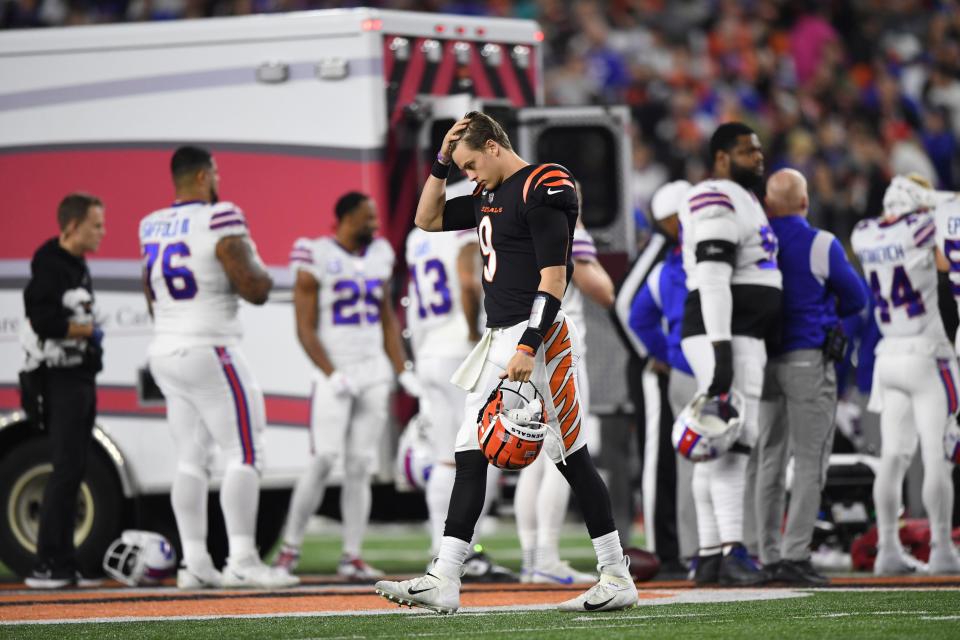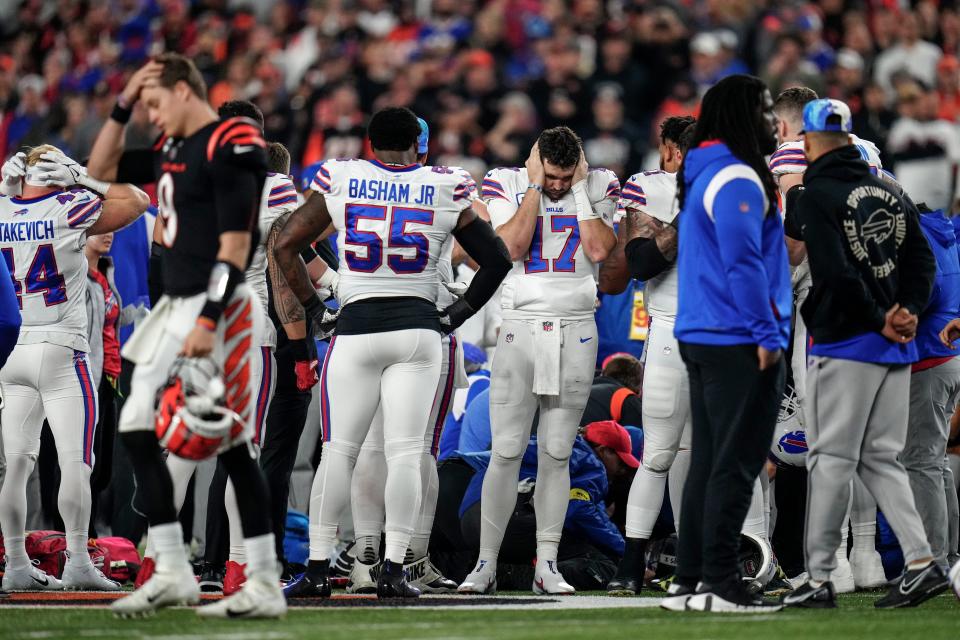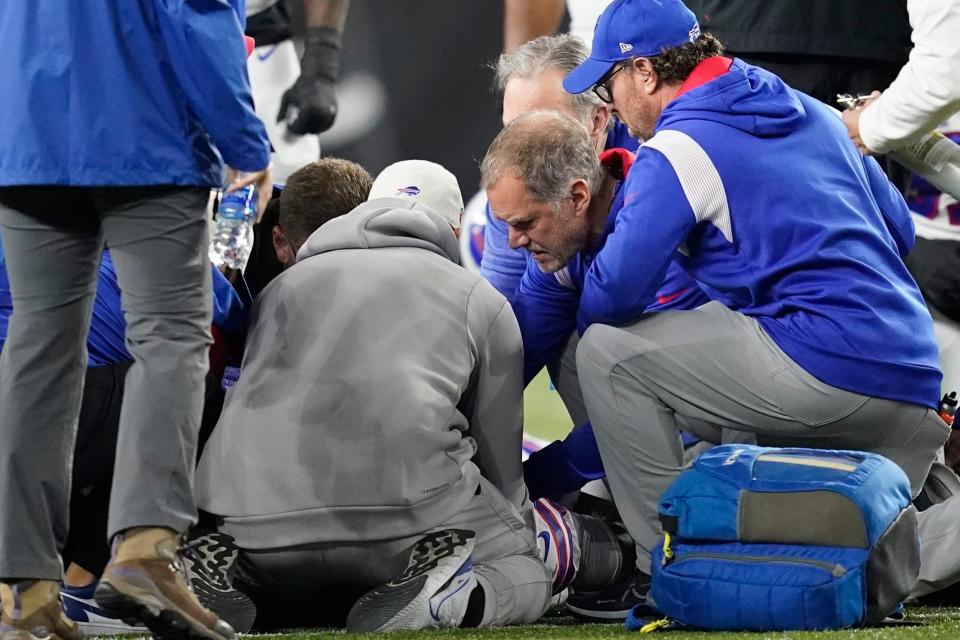Rochester-area company helped Bills train for injury that is 'scariest of them all'
Clarke Brown was watching Monday’s NFL game and from his view as an athletic trainer, the Damar Hamlin medical situation is as frightening as it gets.
“It’s the scariest of them all,” said Brown, owner of BrownStone Physical Therapy and Athletic Training in Canandaigua. “Unlike a joint or muscle problem, time is of the essence here. This is in a class by itself.”
With no official word as to what caused the young Buffalo Bills safety to collapse on the field after making a tackle against the Bengals, Brown points to the growing medical opinion that it was commotio cordis, a disruption of the heart rhythm that is the result of an impact to the chest. A force that hits the area of the heart — like the helmet of Bengals receiver Tee Higgins to Hamlin’s chest as he tried to avoid the tackle — at a precise moment of the beating cycle can send incorrect electrical impulses, which can result in stoppage of the heart.

This can happen in healthy hearts but can also be amplified by pre-existing conditions with the heart that may or may not be known.
In 2004, Cornell lacrosse player George Boiardi died when a lacrosse ball hit him in the chest and in 2012, the same thing happened to 12-year-old Tyler Kopp of Brighton. Both deaths were attributed to commotio cordis.
What is commotio cordis: Condition is discussed as potential cause to Damar Hamlin’s collapse

NFL trainers receive local education
Trainers at games of all levels are prepared for a variety of urgent medical situations, but the absence of a heartbeat and/or breathing is unquestionably the worst nightmare. It didn’t take long for those watching the game to understand the magnitude of what was unfolding as players from both teams shed tears down their stunned faces.
Catching Brown’s attention was the action of the medical personnel Monday night. In addition to radio communication, there are a variety of hand signals that trainers use to relay messages back to the sideline for other personnel. And Monday night, the Bills trainers put a plan into motion not unlike the players on the field taking reps to learn the playbook.
And that plan is largely the product of Mike Cendoma, an athletic trainer and CEO and director of operations at Sports Medicine Concepts in Avon, Livingston County.
The NFL requires annual training for every team in five different injury scenarios, and last night’s situation is one of the five. SMC has worked with all 32 NFL teams and the emergency action plan and the choreography that goes with it is the result of that training.
“My company focuses on simulation-based emergency training,” Cendoma said. “We reproduce what you saw last night so that when it happens, the trainers find themselves in a familiar situation. The environment they’re in … and they have the skills the navigate it. We provide that experience.”
It’s a lot like a NASCAR pit crew, where individuals have specific responsibilities so that minimal time is wasted, especially when time is so valuable.
“All of these things are practiced over and over,” said Cendoma. “There are a lot of moving parts and they all happen simultaneously.”
The synchronized action of the trainers and having an ambulance on the sideline that Cendoma said is basically a functioning trauma unit is a reason to be optimistic for a situation that doesn’t have a lot of it.
“The medical staff had a small window to change the outcome and they were prepared,” he said. “They gave the athlete the best chance to make a recovery from the injury.”
The importance of being prepared at all levels
The obvious focus today is for the recovery of Hamlin but Cendoma said the situation can illustrate the importance for preparedness at all levels of sports. Especially at the high school level, where most games do not have an entire medical staff on hand like NFL games do.
Cendoma emphasizes the small odds of cardiac situations — trainers call it a “black swan event” — like Hamlin’s, but it did happen and it was a high school football game 27 years ago that pushed Cendoma down the road he’s on today.
Six weeks into his career as a trainer, he was tending to a high school football player who suffered a cervical spine injury. As the player was losing consciousness, the player’s mother asked if her son was going to be OK.

“I couldn’t answer her,” said Cendoma. “I just had this overwhelming sense that I was not prepared. … And then I told myself that I was never going to be in that situation ever again.”
The player did recover and Cendoma’s goal as a trainer since then has been focused on being prepared for all circumstances while extending that knowledge to other athletic trainers so they can avoid that helpless feeling while tending to injured players.
All high school coaches in New York are required to have certification in CPR, first aid and AED equipment and the Louis Law of 2001 requires all public schools to have an AED on campus.
But both Brown and Cendoma say that may not be enough. Access to the AED needs to be quick and more people need to know how to use it correctly, especially for sports like football, hockey and lacrosse where shoulder pads and other equipment can take valuable time away from administering AED usage.
“We need to provide a safe environment for athletes and their moms and their families,” said Cendoma.
This article originally appeared on MPNnow: Damar Hamlin injury is 'scariest of them all.' How Bills prepared for it

